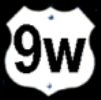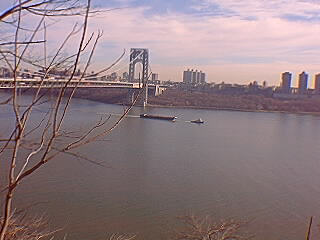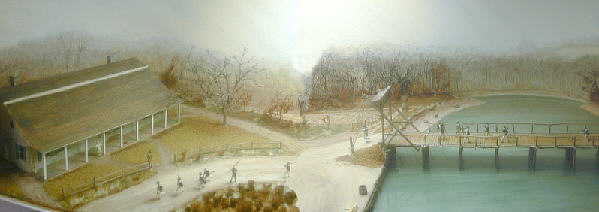FORT LEENEW JERSEY |
 |
FORT LEENEW JERSEY |
 |
 Fort
Lee, today, is a large 33-acre historic park that provides a historical
experience as well as a breath-taking scenic experience. There are two overlooks
that command spectacular views of the George Washington Bridge, the Hudson
River, and the New York skyline.
Fort
Lee, today, is a large 33-acre historic park that provides a historical
experience as well as a breath-taking scenic experience. There are two overlooks
that command spectacular views of the George Washington Bridge, the Hudson
River, and the New York skyline.
The views clearly demonstrate the strategic importance of Fort Lee. Throughout the park are paved pathways that direct visitors past markers illustrating important points about the site.
The Visitor’s Center at Fort Lee is open Wednesday-Sunday,
10 a.m.-5 p.m., March-December. However, the grounds are open year-round from 8
a.m. to dusk.
 A
visit to the center is recommended. One of the highlights is an animated map
that visually shows the entire campaign in New York City, including the Battle
of Long Island, Harlem Heights, White Plains and Fort Washington.
A
visit to the center is recommended. One of the highlights is an animated map
that visually shows the entire campaign in New York City, including the Battle
of Long Island, Harlem Heights, White Plains and Fort Washington.
Fort Lee found its place in American history during the 1776 British campaign to control New York City and the Hudson River.
After the siege of Boston, George Washington correctly
predicted that the British would turn their attention to New York City and the
Hudson Valley. Along with the construction of fortifications at New York City
and Long Island, Washington felt it imperative to build new fortifications along
the Hudson River.
|
FORT LEE In mid-July 1776, General George Washington visited the site of Fort Lee and selected this position for a new fort from which the Hudson could be raked with cannon fire. The first fortifications were batteries built on this bluff, which was called “the mountain” opposite Fort Washington. For the better part of two months, it was an unnamed fortification which was called, variously, the post opposite Fort Washington, the post on the Jersey side, and the post at Burdett’s (Burdette’s) Ferry. In September, the defenses were further extended when a square earthwork with four bastions was erected west of the bluff, on a site bounded by Parker Avenue and Cedar, English, and Federspiel Streets. In September, the post was christened Fort Constitution, and in October was renamed Fort Lee in honor of Major-General Charles Lee, second-in-command of the Continental Army. It was Washington’s hope that Fort Washington and Fort Lee would effectively block the Hudson to the ascent of British ships. In addition, a line of sunken ships and stone-filled timber cribs called cheveaux-de-frize was sunk in the river along a line now spanned by the George Washington Bridge to further block the waterway. (Fort Lee Marker) |
In July of 1776, work was begun on Fort Lee. On the opposite, New York shore, work had already begun on Fort Washington.
 On
July 12, Admiral Richard Howe sent two British naval vessels up the Hudson
River. Cannon fire from Fort Washington had little effect on their passage.
Washington then ordered that work on Fort Lee continue as quickly as possible.
At Major General Israel Putnam's suggestion, sunken ships were placed in the
river channel. With these obstructions and artillery fire from the sister forts,
it was felt that no British ship could sail up the Hudson without sustaining
severe losses.
On
July 12, Admiral Richard Howe sent two British naval vessels up the Hudson
River. Cannon fire from Fort Washington had little effect on their passage.
Washington then ordered that work on Fort Lee continue as quickly as possible.
At Major General Israel Putnam's suggestion, sunken ships were placed in the
river channel. With these obstructions and artillery fire from the sister forts,
it was felt that no British ship could sail up the Hudson without sustaining
severe losses.
King George III, after being stung by events in Boston, sent the largest force of British ships and troops that have ever been assembled by England for combat. By mid-August, Sir William Howe, British Commander-in-Chief, had brought to Staten Island an army of about 31,000 British, Hessian, and loyalist troops. Washington, on the other hand, could only amass about 19,000 troops to meet the challenge. Most were poorly trained and undisciplined state militias.
From August to October, the British and American forces were involved in battles at Long Island, Harlem Heights, and White Plains. The British then turned their forces against Fort Washington. On November 16, Fort Washington fell to an overwhelming assault by the British forces that captured about 2,000 American troops.
General Washington realized that with the loss of Fort Washington, Fort Lee was of little military value. He made preparations to evacuate his remaining army through New Jersey.
|
|
|
THE BRITISH INVASION OF NEW JERSEY The night of November 19-20, 1776, the British forces commanded by Lieutenant General Earl Cornwallis crossed the Hudson River and landed beneath the high Palisades about five miles north of Fort Lee. This diorama depicts the landing and the difficult climb undertaken by the British to surprise the American forces. It is based on the eyewitness watercolor by Davies. (Visitor Center Display) |
An orderly retreat, however, was not in store for the Americans. On November 20, General Cornwallis ferried between 6,000 - 8,000 men across the Hudson north of Fort Lee. When word of the crossing reached Washington, he ordered an immediate retreat before his army was cut off and captured by the British. Most of the American supplies and artillery had to be left behind.

|
|
NEW BRIDGE CROSSING General Washington rode out from his Hackensack Headquarters on November 20, 1776 and led the fleeing American garrison from Fort Lee over the New Bridge. A large part of the Army was saved from entrapment on the Peninsula between the Hudson and Hackensack Rivers. The old wooden span that carried them to safety was later dubbed “the bridge that saved a nation.” (Visitor Center Display) |
